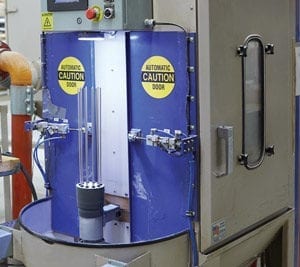
Stainless steels are a versatile alloy of iron widely used throughout the industrial world in countless applications. The alloy is well-known for its high corrosion resistance due to its minimum 10.5% chromium content by weight. But it is more familiar as that shiny, silver-like surface found on many household products in the bath and kitchen.
Why Does Surface Finish Matter?
The importance of stainless steel surface finishes is in providing an added layer of protection against oxidation, corrosion, rusting, and staining. Finishes can meet design needs, too, leaving aesthetically pleasing appearances for architectural or other decorative applications. Some finishing services may require commercial cleaning and capping or thermocouple cleaning and capping of stainless steel material already in service.
Stainless steel surface finishes will largely depend on the intended post-fabrication application. To help in deciding which secondary process is best suited for your company’s needs, here are six common stainless steel surface finishes for consideration.
Types of Stainless Steel Surface Finishes
Sandblasting
Sandblasting is an abrasive blasting finishing technique that uses various blasting materials to achieve a specific finish to a metal’s surface. Common sandblasting media included steel shot, silicon carbide and glass beads which are shot at high speeds through a machine nozzle over a surface until it is sanded smooth. Sandblasting can be done to remove a previous finish, to remove rust or stains, or to prepare a surface to receive a new coat of paint. Glass beads are an excellent choice for stainless steel applications that require a softer, brighter finish, and it has the added benefit of being used multiple times.
Electropolishing
Electro-polishing is a stainless steel surface finish used to polish, passivate, and deburr metal parts. The process uses an electrochemical solution to remove the outer layer of a metal surface, leaving a uniform layer free of embedded contaminants, micro-cracks, pits, and various surface imperfections that could compromise the longevity and performance of a part. Electro-polishing can be applied to a wide range of stainless steel grades and provides a lasting bright finish.
Belt Polishing
As a surface finish, belt polishing leaves stainless steel with a decorative, aesthetic, or high-luster mirrored finish. The process is used on various stainless steel grades and can be applied to meet spec-required finishes for products and parts. It is generally used for appliances, visible structural parts, architectural adornments and the like.
Black Oxide
Black oxide finishing is a blackening conversion coating used on a variety of ferrous metals and alloys, among them, stainless steel. The process is formed by a chemical reaction when the material is immersed in a high-temperature solution. The application provides stainless steel with a surface finish that adds mild corrosion resistance but is ideally applied to meet environmental conditions that minimize light reflection. It is also used to leave surfaces with an aesthetic appearance.
Centerless Ground Finish
Centerless ground finishing is a technique that offers a similar appearance to stainless steel as polished finishes do. The main difference is that the ground finish shows visible circumferential scratch lines as a result of the grinding stone. The finishing details may vary from smooth to coarse depending on the spec requirements. The technique also aids in achieving tight tolerances and even correcting dimensional problems that may arise in structural applications, shafts, threaded rods, fasteners, and the like.
Passivation
Passivation of stainless steel treats the metal surface with an acid solution to further add to surface corrosion resistance. The technique acts to remove any free iron from the metal’s surface before that iron can react to water and oxygen in the air that, subsequently, can cause rust oxidation. As a post-fabrication process, the method also maximizes the natural corrosion resistance of other alloys found in stainless steel. Once the surface is treated, other alloys that comprise the material such as chromium or nickel react with oxygen to form an oxide layer that protects the underlying metal surface from corrosion. There are two methods used to treat stainless steel surface finishes, citric acid passivation and nitric acid passivation.




